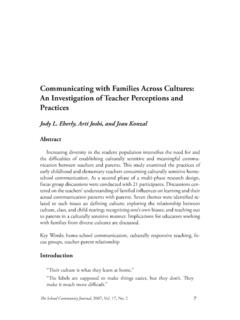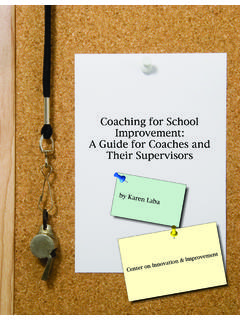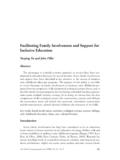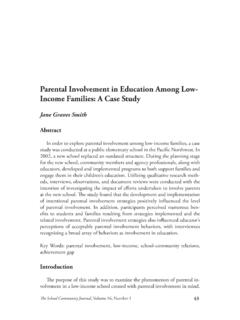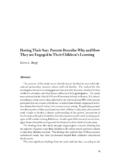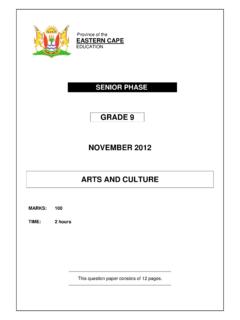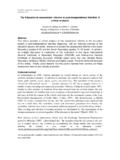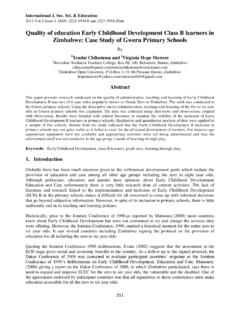Transcription of An Action Guide for Instructional Planning and …
1 Page 1 of 67 An Action Guide for Instructional Planning and collegial learning : Effective Practices and the Common Core State Standards november 2012 2012 Academic Development Institute, Lincoln, IL Page 2 of 67 Preface Teachers are accustomed to change. They are always open to more effective ways to teach, even while they know that many Instructional practices stand the test of time. Teachers are always blending the best practices they have built through years of experience with new approaches that add to their effectiveness.
2 Teachers are busy people. They want their students to succeed. Though they may not be professional researchers, they care about what works in the classroom. They glean what they can from new research and new methods. Teachers appreciate the knowledge of colleagues and savor opportunities to share. The practices in this Guide are both current and time-tested. They seamlessly blend the new terminology and structures of Common Core State Standards with best Instructional practice. This Guide is most meaningful when applied by a group of teachers, bringing to it their own experiences and insights.
3 So, pull-up a chair, and let s get started. This Action Guide was written for teacher teams. The explanations are written in short, friendly format meant to encourage quick digestion, engaging discussion, and practical application. Framework examples are provided. This process is aligned to a list of effective practices that are time-tested and research-based. In addition, this Guide is meant to assist teacher teams in the use of the Common Core State Standards. The Guide is divided into two parts. Part I: Instructional Planning establishes a framework for teachers working as a grade level or subject area team.
4 In this process, teams assess and amend their current curriculum map and Instructional practices based on the Indicators of Effective Practice. Additionally, they integrate the Common Core State Standards into their work. Part II: collegial learning promotes ongoing and systematic teamwork to continue the process, document collective Planning , and measure and improve the results through observational support. Instructional Planning by teacher teams ensures Instructional alignment to standards that helps prepare students to succeed in college and careers.
5 Team Planning is a powerful form of embedded professional development in which teachers learn from each other and together. Team-based Instructional Planning goals: 1. Reduce the time necessary to put powerful teaching practices in place 2. Improve Instructional Planning and delivery with the Common Core Standards 3. Focus on effective practices 4. Meet the individual learning needs of each student in the classroom collegial learning enables teachers to continue learning from one another, from the trials and errors of expanding their work, and from each student s story as they internalize the Instructional methods that have been developed.
6 collegial learning contributes to the school s continuous improvement. collegial learning will: Page 3 of 67 1. Keep the momentum for continuous Planning moving and secure the teaming for future Instructional Planning 2. Ensure the quality of individual Planning with collaborative documentation for the grade level and subject 3. Use an observation instrument for self-reflection and team support Page 4 of 67 Table of Contents Indicators of Effective Practice Page 6 Definition of Terms Pages 7-8 Part I: Instructional Planning Page 9 Step 1: Organize Instructional Units for the Year Pages 10-11 Scope and themes Essential questions Worksheet Step 2.
7 Align Units with Grade-Specific Standards Pages 12-13 Common Core, subject area standards, other subject standards to complement an interdisciplinary unit (whenever possible) Worksheet Step 3: Develop Two Week Plan Pages 14-18 Target learning statements Assessment(s) for target learning statements Leveled learning statements: enhanced (above target), prerequisite (below target) Worksheet Step 4: Create Daily Instruction Plans Pages 19-25 Preview and sample plan Whole Class and Small Group, Teacher-Directed Instruction Student-Directed Group Step 5: Personalize learning Activities Pages 26-32 Work Time Independent Work and Computer-Based learning Homework Step 6: Manage Work Time Pages 33-36 Leveled learning Plan Self-Directed Learners Step 7.
8 Record and Report Student Progress Pages 37-39 Class Progress Chart Student learning Report Step 8: Use Student learning Plans (optional) Pages 41-43 Page 5 of 67 Part II: collegial learning Introduction Page 45 Step 1: Continue Development of Units of Instruction Page 46 Step 2: Document Plans Pages 46-51 Whole Class Instruction Student-Directed Groups Independent Work and Computer-based learning Homework Step 3: Support Colleagues Pages 52-55 Teacher Interview and Classroom Checklist Literature Review of Effective Practice Indicators Pages 56-65 References and Resources Page 66-67 Page 6 of 67 Indicators of Effective Practice Planning 1.
9 All teachers are guided by a document that aligns standards, curriculum, instruction, and assessment. 2. Units of instruction include specific learning activities aligned to objectives ( learning statements). 3. All teachers develop weekly lesson plans based on aligned units of instruction. 4. All teachers individualize instruction based on pre test results to provide support for some students and enhanced learning opportunities for others. Instruction 5. All teachers use a variety of Instructional modes (teacher-directed, whole class; student-directed group; teacher-directed group; independent work; computer-based; homework).
10 6. All teachers differentiate assignments (individualize instruction) in response to individual student performance on pre tests and other methods of assessment. 7. All teachers maintain a record of each student s mastery of specific learning objectives ( learning statements). Interaction 8. All teachers interact instructionally with students (explaining, checking, giving feedback). 9. All teachers interact managerially with students (reinforcing rules, procedures). 10. All teachers interact socially with students (noticing and attending to an ill student, asking about the weekend, inquiring about the family).
